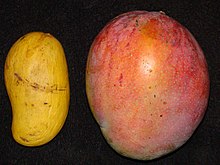Ataulfo (mango)
| Mangifera 'Ataúlfo' | |
|---|---|
 Ataúlfo mango (left), Tommy Atkins (right) | |
| Genus | Mangifera |
| Species | Mangifera indica |
| Cultivar | 'Ataúlfo' |
| Marketing names | Champagne |
| Origin | Soconusco, Chiapas, MX |
The Ataúlfo, also called young, baby, yellow, honey, Adaulfo, Adolfo, or Champagne,[1] is a mango cultivar from Mexico.[2] Ataulfo mangos are golden yellow and generally weigh between 6 and 10 ounces (170 and 280 g), with a somewhat sigmoid (oblong) shape[2] and a gold-blushed yellow skin.[3] Their buttery flesh is not fibrous, and they have a thin pit. Their flesh is a deep yellow and high in sugar (15 grams per 100-gram serving), with a rich, sweet flavor. They were named for grower Ataulfo Morales Gordillo.[4]
Origin
The Mexican Institute of Industrial Property (Instituto Mexicano de la Propiedad Industrial) granted the designation of origin of this fruit to the government of Chiapas.[4] Along with the Manilita mango, it is a descendant of the Philippine mango cultivar introduced from the Philippines to Mexico before 1779 through the Manila-Acapulco galleon trade. It was crossed with other mango varieties, resulting in the Ataulfo. Regardless, Ataulfo remains a Philippine-type mango, characterized by being polyembryonic (as opposed to the Indian-type which is monoembryonic).[5]
In 1958, the agronomist Hector Cano Flores (the discoverer of Ataulfo mango) reportedly made a clone of an Ataulfo mango which he named IMC-M2.[citation needed]
In 2003, the Mexican government, through the Official Gazette, published Comunicado No. 14 – 2003 titled “Abstract of the application for the declaration (protection) of the Appellation of Origin: Mango Ataulfo del Soconusco Chiapas,” a declaration that the term “Mango Ataulfo del Soconusco Chiapas” is an appellation of origin for a specific kind of mango fruit produced in several regions of Chiapas, Mexico[6] where the Ataulfo was first grown by Ataulfo Morales Gordillo.[4]
Production
The fruit grows in warm, moist climates with summer rains, but monsoon temperatures must not decline to 41 °F.[citation needed] The proper temperature for this type of mango is 83 °F with rainfall between 1090–3000 mm annually, from April to October.[citation needed]
The Ataulfo mangoes originate in the Mexican states of Michoacan, Sinaloa, Nayarit, Jalisco, Veracruz and Chiapas, and are sold between March and September.[3] In the Mexican state of Chiapas, mango production was, as of 2008, the sixth most important agricultural activity, based on cultivated surfaces, following corn, beans, coffee, sugar cane and cocoa.[citation needed] Ataulfo production in that state was concentrated in the Soconusco coastal region. Overall, producer organizations estimated that there were 18,000 hectares of Ataulfo mangoes in production in the state.[7]
Consumption
Ataulfo mangoes gained popularity in the United States beginning in the late 1990s,[8] though they have been a major crop in Mexico for decades.[4][2] As of 2009, they were the second-most popular variety of mango sold in the U.S., behind the Tommy Atkins.[9] As of 2018, they represented a little less than 20% of all mangoes imported into the U.S.[10]
Until 2014, Mexican ataulfo mangoes had not been sold in significant numbers in Europe because shipping them by air was prohibitively expensive.[11] In December 2014, shipments by sea began via one United Kingdom importer using timed pre-ripe harvesting combined with faster sea-shipping that enabled full mango ripening while in transit.[11] European customers are willing to pay significantly more than North American customers, if the mangos are of high quality and are sold ready-to-eat.[12]
References
- ^ Krystal, Becky (April 16, 2018). "How to prep and enjoy a mango, the sunniest fruit in the grocery store". Washington Post. ISSN 0190-8286. Retrieved June 22, 2018.
- ^ a b c Allen Susser. The Great Mango Book. Ten Speed Press (2001), p. 6 ISBN 1-58008-204-1.
- ^ a b Corey Mintz (May 24, 2008). "Sweet news: Ataulfos are in season; It's hard to believe these silky mangoes are related to the stringy variety we see in winter". Toronto Star.
- ^ a b c d "Ataulfo mangoes". Specialty Produce. 2016. Retrieved 20 October 2016.
- ^ Rocha, Franklin H.; Infante, Francisco; Quilantán, Juan; Goldarazena, Arturo; Funderburk, Joe E. (March 2012). "'Ataulfo' Mango Flowers Contain a Diversity of Thrips (Thysanoptera)". Florida Entomologist. 95 (1): 171–178. doi:10.1653/024.095.0126.
- ^ "Mango Variety Granted Appellation of Origin". INTA Bulletin, International Trademark Association. 1 May 2003. Retrieved 8 December 2015.
- ^ Patrick Hanemann; Nathanael Bourns; Ivana Fertziger (July 2008). "Ataulfo Mango in Chiapas: A Value Chain Analysis" (PDF). Archived from the original (PDF) on 2011-07-24.
{{cite web}}: Unknown parameter|deadurl=ignored (|url-status=suggested) (help) (USAID microREPORT #109 - ^ Aliza Green. Starting with Ingredients. Running Press (2006), p. 572. ISBN 0-7624-2747-7.
- ^ Erica Marcus (June 10, 2009). "Mangoes win in popularity". St Louis Post-Dispatch.
- ^ Riemenschneider, Pamela (April 3, 2018). "Retailers find a sweet spot with honey mangoes". Produce Retailer. Retrieved June 22, 2018.
- ^ a b Watson, Nichola (December 8, 2014). "First seafreight Ataulfo mangoes to UK". FreshPlaza.com. Retrieved 2015-05-15.
- ^ Thompson, Tad (June 5, 2018). "Splendid greatly increasing Ataulfo volume in 2018". The Produce News. Retrieved June 22, 2018.

